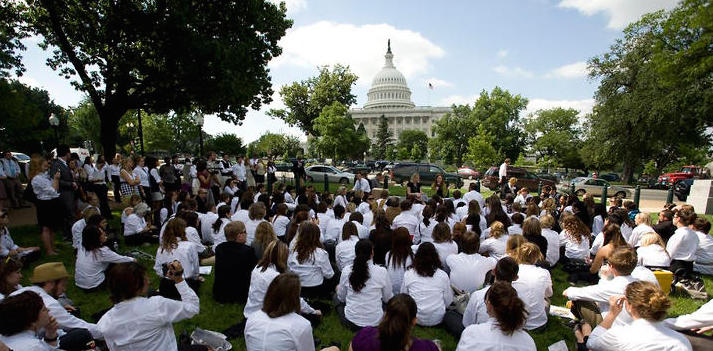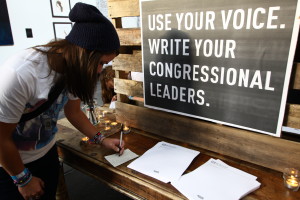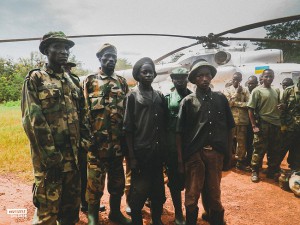It goes without saying that to be an effective and responsible activist, you’ve got to be an informed one. That’s why we love it when you geek out over the details as much as we do, and why we wanted to provide you with lots of information about the LRA Resolution and why it’s so important. Have fun reading your little activist heart out, and if your questions aren’t answered in resources below, shoot us an email at [email protected].
ABOUT THE LRA RESOLUTION
What does the LRA Resolution actually say?
We’re glad you asked! There are actually two resolutions: a Senate version (S.Res. 237) and a House version (H.Res. 394) that are pretty identical. You can read the Senate resolution here and the House resolution here. Generally speaking, these resolutions express Congress’ support for international efforts to end LRA violence, arrest Joseph Kony, and promote the recovery of communities that have been affected by the LRA crisis. The resolutions also urge the Obama Administration and other international governments and institutions to stay committed to the mission until it’s fully accomplished, and communities in central Africa are on the road to lasting peace and recovery.
Here are some of the key things that the LRA Resolution emphasizes:
1) Congress’ support for the extension of the U.S. advisor mission to support the African Union until top LRA commanders are removed from the battlefield and the LRA no longer poses a significant threat to communities in central Africa
2) Congress’ desire for the Obama Administration to help address the issue of the LRA’s ability to enjoy safe haven in areas like the Kafia Kingi enclave, controlled by Sudan
3) The need for continued efforts by the African Union, United Nations, and regional governments to protect civilians from LRA violence, and expanded efforts by the U.S., regional, and international partners to support the defection, return, and reintegration of LRA abductees
4) The need for the Obama Administration to increase efforts that help prevent the LRA’s participation in illicit ivory and mineral trafficking
5) Congress’ desire for the Obama Administration, together with regional and international partners, to develop a strategy focused on promoting lasting recovery and security of LRA-affected communities
Why is the LRA Resolution important?
U.S. support to LRA-affected communities and to regional efforts to stop LRA violence and arrest its top leaders is critical in order to bring this crisis to an end once and for all. We must make sure it continues, and right now, rallying support behind the LRA Resolution is the best thing we can do to make sure that happens.
Together with community leaders and regional governments in LRA-affected areas, we’ve made incredible progress in decreasing LRA atrocities, encouraging LRA fighters to peacefully surrender, and bringing top LRA commanders to justice. We have so much to celebrate, but giving up before the job is done would be incredibly dangerous and irresponsible. With Joseph Kony still at large, and still having strong control over his forces, and with evidence of increased LRA attacks and abductions in areas of DRC and CAR where there hasn’t been adequate protection, we have every reason to believe that walking away from this mission too soon would have disastrous consequences for communities in central Africa — and it’s exactly what Kony is waiting for us to do.
While there still are some incredible champions in Washington who remain committed to ending LRA violence, there are definitely others who think that we’ve done enough and it’s time to walk away. They either don’t know or don’t care about the consequences that walking away too soon could bring, and some of them assume that the American public (you!) just won’t care.
That’s why it’s so important for you to speak up and get your members of Congress to support the LRA Resolution. Not only will strong support for the Resolution show our leaders in Washington how committed we all are, it will also push them to take the actions needed to finally see this mission through to success. And by success, we don’t just mean arresting Kony, we mean supporting LRA-affected communities in their journey toward lasting peace and recovery after LRA violence is finally over.
President Obama only has about 16 more months left in office. After his term, we have no guarantees that the next Administration will continue to be committed to bringing this crisis to an end. So we’ve got to make sure that the President does everything he reasonably can before his term ends to address key gaps in current efforts to end LRA violence, and establishes a plan for how the U.S. will help communities in the region recover and restart their lives.
ABOUT LOBBYING YOUR REPRESENTATIVES
What does “cosponsor” mean?
By cosponsoring a bill or resolution, a member of Congress is signing on as an official expression of support. The more cosponsors a bill or resolution has, especially when those cosponsors are bipartisan (a combination of republicans and democrats), the more likely it is to be passed, and the more influential it will be. That’s why we need you to make sure that both of your senators and your representative sign on as cosponsors on the LRA resolution. For some of you, one or more of your members of Congress might have already signed on as cosponsors, in which case you’ll want to say a big “thank you!”. Click here and type in your zip code to find out who your members of Congress are and if any of them have already cosponsored.
Do we need a certain number of cosponsors on the LRA Resolution?
A resolution doesn’t require a certain number of cosponsors in order to pass. However, the more cosponsors it receives, the stronger and more influential the message will be to the Administration that ending LRA violence is something that Congress, and the American public, really care about.
That said, we love concrete goals! If we can get 40 cosponsors on the House resolution and 20 cosponsors in the Senate, we’d be stoked! It’s up to to you to make sure YOUR members of Congress cosponsor so we can reach that goal.
Should I really call, email and tweet my representatives? Can’t I just pick one?
Technically, you could choose just one, but where’s the fun in that? Go big or go home, right? Each of your three members of Congress is important to making sure the LRA Resolution is a success. And they’ll only sign on as a cosponsor if they know it’s important to you. So we encourage you to call, email and tweet each of them (at least once). We’ve made the process really quick and easy for you!
Ok, so I’ve called, emailed and tweeted my representatives. Now what?
Well first, thank you for taking action! But you’re not done yet. It may take several rounds of persistent outreach to get each of your policymakers to cosponsor. So over the next few weeks, we need you to continue to take action. We’ll be sending you weekly missions – fun and effective ways encourage and inspire your representatives in Washington to join us in our commitment to peace by cosponsoring the LRA Resolution.
About the LRA Crisis
As a global community, we have made truly historic progress toward ending LRA violence. But the crisis isn’t over yet. Top commander Joseph Kony remains at large, with ongoing evidence that he has been enjoying safe-haven in the Sudan-controlled areas of Kafia Kingi and South Darfur. LRA attacks and abductions have actually increased over the past 18 months, particularly in Democratic Republic of Congo (DRC), and communities in central Africa that have suffered from years of LRA violence (including the children, women, and men who were once held captive by the LRA) have received very little support to help them recover and restart their lives. Needless to say, while there is a lot of progress that we should celebrate, our work is far from over, and LRA violence continues to be a significant threat for hundreds of thousands of people across central Africa. If these communities can’t walk away from the continued reality of LRA violence, then neither can we — and neither can our leaders in Washington who represent us.
For an incredibly thorough analysis of the current LRA conflict and what is needed to help bring it to an end, check out the newest report from The Resolve LRA Crisis Initiative, entitled The Kony Crossroads | President Obama’s Chance to Define His Legacy on the LRA Crisis (Aug 2015).
How are the U.S. advisor in central Africa helping?
As one component of a comprehensive strategy, the U.S. advisor mission in central Africa continues to play a critical support role to regional efforts to dismantle the LRA, bring top LRA commanders to justice, and promote security in region. Some of the most important contributions that the advisors are making to the mission include:
1) Intelligence gathering and analysis, and information-sharing between the security forces in DRC, CAR, and South Sudan
2) Defection initiatives, including the dissemination of “Come Home” messages through fliers, FM radio broadcasts, and aerial speakers, encouraging the peaceful surrender of LRA fighter
3) Provision of mobility support (helicopters, etc) to African Union forces so that they are able to more rapidly respond to information on LRA activity
There are certainly still gaps and areas of improvement in the US advisor mission that must be address in order to achieve success, but overall, the mission itself is critically important and needs to continue. Thankfully, the LRA Resolution emphasizes this too, which is why you need to get your members of Congress to cosponsor!
What else is needed to help end the LRA crisis?
The LRA Resolution does a pretty great job of addressing the most important gaps that must be address in order to successfully end the LRA crisis. We definitely encourage you to read through that lovely gem, especially since you’re asking your members of Congress to cosponsor it! But here’s a quick rundown of some of the biggest things that the U.S. government, and other international and regional governments must do to see this crisis finally ended:
1) President Obama must extend the U.S. advisor mission in central Africa
2) The U.S., African Union, regional governments, and the United Nations must work together to disrupt LRA safe havens and trafficking networks in Kafia Kingi and South Darfur, Sudan
3) The African Union and regional governments, with support from the U.S., must work to prevent LRA forces from enjoying safe haven and obtaining ivory in DR Congo
4) The Obama Administration should work together with regional partners to ensure that U.S. and African Union security force are better supported with intelligence-gathering and mobility resources
5) The Obama Administration should support increased defection efforts by the U.S. advisors to encourage the peaceful surrender of LRA fighters
6) The U.S., African Union, regional governments, and the United Nations must work together to improve civilians protection and promote human rights in countries/regions affected by LRA violence.
7) The U.S. and other donor nations must invest more in supporting the long-term recovery and resilience of communities affected by LRA violence.
Where is Joseph Kony and why hasn’t anyone captured him yet?
In a nutshell, the answer is this: There has been plenty of evidence over the last several years that Joseph Kony and his closest circle of LRA fighters and captives have been hiding in the Sudan-controlled region known as Kafia Kingi, as well as in South Darfur. The problem is that, even if African Union and U.S. forces have intelligence on his location, these areas are extremely difficult for them to access, both logistically but also politically, in order to arrest him.
Additionally, other LRA groups have strategically moved into another relative safe haven — DR Congo — where they can escape military pressure from Ugandan Africa Union forces that are not allowed in DRC. These LRA groups are also poaching elephants in Congo’s Garamba National Park, under Kony’s orders, and trafficking that ivory up to Kony’s group in Kafia Kingi and South Darfur. The LRA collected at least 50 elephant tusks there in 2014 alone, while also collecting gold and diamonds from mines in Central African Republic (CAR) and trading them with various other rebel fighters and traders in CAR. Over the last several years, these illicit natural resources have become a key source of revenue for Kony and his forces, who trade them in informal markets in eastern CAR, Kafia Kingi, and South Darfur. Kony’s ability to acquire ivory, gold, and diamonds (gathered by LRA groups in DRC and CAR under Kony’s orders) is likely a key reason why he has been able to enjoy safe haven in the Kafia Kingi and South Darfur areas for all of these years.
How many people is Kony holding captive?
Currently, we can reasonably estimate that the LRA is made up of about 150-200 fighters (most of whom were abducted as children in Uganda), and an additional 250-300 women and children captives. However, LRA groups in DRC and CAR continue to abduct civilians on almost a daily basis, sometimes holding them captive for a few days to serve as porters and then releasing them, or other times keeping them captive indefinitely. Additionally women held captive in the LRA who are forced into sexual slavery will often give birth to children in the bush. This makes it difficult to know exactly how many women and children captives are in the LRA at any given time.
It’s also important to note that, while they may not be directly held captive within the LRA, hundreds of thousands of civilians across DRC, CAR, and South Sudan remain captive psychologically due to the fear of renewed LRA attacks on their families at any moment. Many communities, or displaced populations, which have not experienced an LRA attack in almost a year or more still remain fearful of going out to their fields to grow food, or to return to their home villages from which they were displaced. For many, the trauma of what they’ve experienced at the hands of the LRA, and the uncertainty they feel with Kony still at large, can be it’s own form of captivity that keeps them from being able to restart their lives, earn an income, and feed their families.
OTHER GOODIES YOU SHOULD READ:
The Resolve LRA Crisis Initative | The Kony Crossroads: President Obama’s Chance to Define His Legacy on the LRA Crisis (Aug 2015)
LRA Crisis Tracker | The State of the LRA in 2015
Op-Ed from The Enough Project | An Evolving Obama Success Story in Africa (July 2015)
UN Security Council | Statement on Central Africa / LRA Conflict (June 2015)
Conciliation Resources | Back But Not Home: Supporting the reintegration of former LRA abductees into civilian life in Congo and South Sudan (August 2014)
Conciliation Resources | Safe Paths Home: Protecting civilians and supporting reintegration in LRA affected communities (July 2014)
Conciliation Resources | In New Light: Protection of civilians, the Lord’s Resistance Army, and the African Union Regional Task Force (May 2015)



Think people should hear about this?